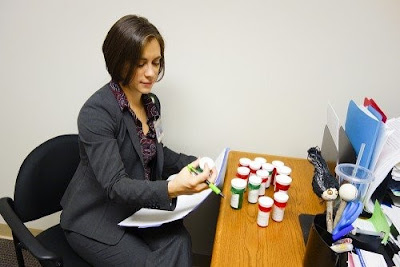Young and old use different strategies to estimate
passage of time, study finds
Newswise, January 16, 2017--A song
is just a song, but as time goes by, something as random as a song’s length
could be the difference in whether you miss an important deadline or arrive
late for an appointment, suggests time-management research from Washington
University in St. Louis.
The study, published in the Journal
of Experimental Psychology: General, shows that people rely heavily on time
estimates of past experiences to plan for future tasks and that outside
influences, such as background music, can skew our perception of time, causing
even the best-laid plans to go awry.
“Our results suggest time estimates
of tasks that we need to incorporate into our later plans, like a drive to an
appointment, are often based on our memory of how long it took us to perform
that same drive previously,” said Emily Waldum, principal author of the paper
and a postdoctoral researcher in psychological and brain sciences in Arts &
Sciences.
“Even if you think you estimated the
duration of events accurately, external factors unrelated to that event can
bias time estimates,” she said.
“Something as simple as the number
of songs you heard play on your phone during a run can influence whether you
over- or under-estimate the duration of the run.”
In a complicated modern world where
multitasking is the norm, it’s easy for our game plans to fall apart due to
breakdowns in “prospective memory,” a term psychologists use to describe the
process of remembering to do something in the future.
Waldum and co-author Mark McDaniel,
a professor of psychological and brain sciences, designed this study to tease
out differences in how people young and old approach a challenge that requires
them to plan ahead and complete a series of time-based tasks by a specific
deadline.
The research included 36 college
undergraduates and 34 healthy older adults in their 60s, 70s and 80s. It aimed
to simulate the complicated time-based prospective memory (TBPM) challenges that
people old and young experience in everyday life.
In the first part of the study,
participants were asked to keep track of how long it took to complete a trivia
quiz. The quiz always ran 11 minutes, but participants had to make their own
time estimates without access to a clock. Some completed the quiz with no
background noise, while others heard either two long songs or four short songs.
Later, the participants were
challenged to put together as many pieces of a puzzle as possible while leaving
enough time to complete the same quiz before a 20-minute deadline.
Contrary to previous research, this
study found that seniors managed to complete future tasks on time at about the
same rate as college undergraduates, although each age group used surprisingly
different strategies to estimate how much time they would need to repeat the
quiz and finish the next phase of the experiment on deadline.
Older adults reported ignoring songs
heard in the background, relying instead on an internal clock to estimate how
long it took them to complete the first quiz.
Consistent with other research on
internal clocks and time perception, seniors in this experiment tended to
underestimate time taken on the first quiz. This led them to spend a little too
much time on the puzzle and to finish the second quiz a bit beyond deadline.
“When younger adults heard two long
songs during the first quiz, they performed a lot like older adults,
underestimating the quiz duration and winding up a bit late,” Waldum said.
“When they heard four short songs,
younger adults overestimated how much time they would need to repeat the quiz
leading them to finish it too early.”
Thus, older adults performed about
the same, regardless of whether they heard songs or not. For young people
though, background music played a big role in whether they were too early or
too late, Waldum said.
While the challenges of being on
time may remain largely the same throughout a lifetime, this study suggests
that the tricks we use to stay on schedule may evolve as we age.
For college students with young,
agile minds and no fear of multitasking, using songs to estimate the passage of
time may be a plausible approach when no clock is available.
“In a scenario where the duration of
a background event is set, such as a 30-minute television show, this is a very
good strategy because it provides useful duration information whether you’re
paying attention to the show or not,” Waldum said.
“However, when background events are
less predictable, as in the case with songs and many other events, basing a
time estimate on them can be risky.”
Older adults, who generally see
declines in memory and the speed at which they process information, tended to
avoid multitasking throughout the study.
During the first quiz, they ignored
songs and relied more on an internal clock to make time estimates. In the
second phase of the study when a clock was made available, they were less
likely to pause working on the puzzle and quiz to check the clock.
These findings suggest that older
adults may actually over-rely on their internal clocks that give us a feeling
of elapsed time. Checking a clock when it is available is a much better
strategy than relying on a feeling of elapsed time, and indeed increased
clock-checking predicts better time-based prospective memory performance in
this and many other previous studies.
Therefore, even if checking the
clock requires some multitasking, it is worth your time, Waldum said.
No matter what challenges the future
brings — getting out the door and to work, finishing walking the dog before the
cookies are done or purchasing popcorn before a movie starts — the fundamentals
of being on time still apply.
You must remember this: Success
requires making accurate estimates of the time needed to complete prerequisite
tasks, remembering to carry out these tasks at the appropriate time and
avoiding distractions that could prevent you from staying on schedule.
“Our study provides some good news
for older adults,” Waldum said. “Our results, while preliminary, suggest that
time-management ability and the ability to perform some types of complex
time-based tasks in real life may largely be preserved with age.”






